Following on from the last Trove Tuesday we continue reading an account of Wangaratta published in the Ovens & Murray Advertiser (O&MA) in January 1863.
A tannery has been lately established in Templeton-street, and but for the doubts entertained by the neighbors, as to its effect upon the already sufficiently dirty waters of the Ovens, would be hailed with satisfaction as an addition to local enterprise, although not a novelty, as a tannery has been in operation in North Wangaratta for some years.
It was a fact of early colonial life that many industries relied on water from rivers. Many used the water in a way that polluted the very water needed for drinking. Slaughterhouses and tanneries were infamous for being one of these big polluters. The Encyclopedia of Melbourne’s entry on noxious trades noted that trades processing the “by-products of livestock slaughtering – the blood, bones, fat, hair, wool, hooves, and the offal – were located near the public and private abattoirs, themselves usually sited along … rivers and creeks”. In Melbourne air and water pollution were apparent “particularly during the upsurge of boiling-down of surplus stock during the 1840s depression, and during the meat-preserving boom of the late 1860s and early 1870s”. Tanners, fellmongers and wool-washers preferred the upper reaches of waterways where fresh water could be obtained. They caused water pollution that flowed straight through the nearest town.
The O&MA identified the proprietors of the Wangaratta tannery as Messrs Boyd and Leishman. An editorial in May 1863 claimed “some first rate leather” was being produced. “Their arrangements are not quite completed yet, but I am positive that in a very short space of time the leather produced at this establishment will compete successfully with either the Melbourne or home country productions. I saw a first-rate sample of harness leather at the tannery to-day, and I would request saddlers and harness makers, for their own benefit, to pay a visit to that establishment.”
Mr Boyd was probably William Boyd who removed himself from a partnership with Dennis Hallahan and Matthew Dodd in the Ovens Tannery at Newtown, Beechworth in August 1862. Thomas Leishman was the other partner. Leishman’s sons carried on the business after the death of their father in 1901, only selling it after the death of Thomas junior in 1917. The tannery barely gets a mention in newspapers, advertisements were rare, and images non-existent. The lack of advertising may have been because, apart from the Ovens Tannery at Beechworth, it was the only such establishment in north-eastern Victoria and the need to differentiate from the competition did not exist. This newspaper article places the tannery right in the middle of a rather unusual town event 50 years after the tannery was established.
On Thursday, while being used to draw tan from Mr. Leishman‘s tannery to the circus tent, the elephant got beyond control of the driver. He broke away, and in the rush along the street caused pedestrians returning from the show to scatter in all directions to places of safety. Horses were startled, but fortunately no accident occurred. The elephant was finally secured by his keeper, and brought under subjection once more.
When Christina, the widow of Thomas Leishman senior died in 1909, her probate noted that she owned part of Lot 2 and Lots 3, 4, and 5 in section 38 of Wangaratta with a frontage to Templeton Street. The property included a brick house of seven rooms with an old tiled roof and iron veranda. The house was on a narrow block of approximately 25 feet of flat land before it sloped sharply northwards down towards the river. Also on the property were two “very old” wooden shingle roofed sheds used for storing bark and “a very old open shed containing 36 pits used as a tannery and drying shed.” Whittaker placed Leishman’s tannery “in Templeton Street near the railways line and on the river bank. It extended over a whole block with it’s soaking pits etc.” The tannery was less than a block from Mackay & Reid’s Wangaratta Steam Flour Mill that we looked at in Part 1 of this series, and marked the eastern end of Templeton Street as an industrial precinct .
An interesting thing about this is that the Lots were originally purchased by James Meldrum (Lot 2), Patrick Cusack (Lot 3), and William Thomson (Lots 4 & 5). James Meldrum was the licensee of the Wangaratta Hotel. Patrick Cusack, was a son of inaugural councillor, butcher and auctioneer Michael Cusack. William Thomson was a Scottish bootmaker, who had his main business along the same line of road in Faithfull Street in 1863. It is possible he bought the block in Templeton Street and later moved his business to Faithfull Street closer to the commercial district. Thomson was also one of the men nominated to stand for election at the first council elections. His speech was remarkable for saying only that “he was not much of an orator”. Not surprisingly he polled 14th out of 16 men who stood. The next year Thomson was appointed council assessor (of rates) along with Samuel Norton.
For many years, Wangaratta felt the proud and profitable duty of purveying beer for the thirsty souls and bodies of the Ovens gold-fields, and ‘Meldrum’s ale’ was joyously quaffed through the length and breadth of the Murray Valley, permeating the bush in all directions ; but, alas ! for the mutability of human affairs, not only has Ovens water ceased to irrigate the stomachs of Beechworth and Albury, but Kerferd’s entire has actually flooded the original article out of Wangaratta. It is to be hoped, however, that the brewery now, in new hands, will resume its pristine prosperity.
While many people in the North east obtained their water from rivers and creeks, breweries also tapped into the supply. Ironically, beer and spirits were often used as substitutes when clean water was not available. The entry in the Encyclopedia of Melbourne for colonial breweries notes that brewing was a precarious business in the early days. “The greatest demand was in hot weather when it was virtually impossible to make good beer. Efforts were made to brew in the cooler months, and store it, though there was no adequate refrigeration until the late 1880s.”
Meldrum’s Ale advertisement 1855
Meldrum’s Ale was a brew concocted by storekeeper and Wangaratta Hotel owner and licensee James Meldrum, at his unimaginatively named Wangaratta Brewery. An early resident of Wangaratta, in the Victorian Government Gazette of 1855 Meldrum was recorded as being a spirit merchant and brewer residing on the corner of Reid and Murphy Streets.
As evidenced from his obituary Meldrum made a great deal of money from his ale. “A small brick building, originally used as a fellmongering establishment, was converted by him into a brewery, and for several years the profits exceeded £400 per week. In a very short time he accumulated a fortune of £50,000.” However most of this fortune was lost when Meldrum became insolvent.
Meldrum’s store and brewery on the corner of Reid and Murphy Streets was in the central business district of Wangaratta. Once known as London House, old Wangarattians will know the corner and building as Osmotherly’s.
Kerferd’s Brewery was located in Beechworth so the dominance of an ale from a rival town must have irked the locals, not to mention made obtaining the drink more difficult, hence the hope that the new owners of the Wangaratta Brewery would fix that issue. The Wangaratta Brewing and Malting Company that was formed after the collapse of Meldrum’s brewery had a grand ceremony for the laying of a foundation stone at the new Chisholm Street location in September 1868. Unfortunately for the numerous local subscribers, not to mention the drinkers, the business was a failure.
George Edmondson (recorded as Edmonston) of the Australian Hotel tried his hand at brewing in early 1865 but doesn’t seem to have made a success of it. Francis Couch Michell, owner of the Royal Victoria Hotel started the Victoria Brewery in Grey Street on the banks of the Ovens River before 1872 when he sold or rented it to John Dodsworth and Michael Moloney. Dodsworth bought out the Wangaratta Brewing and Malting Company in 1877 but failed to make a success of it as the water from the King River was deemed unsuitable for brewing.
The only brewery that seemed to survive in any form, although a much later business, was the Buffalo Brewery in Phillipson Street (then Boundary Road) which was understandably, located outside the borough boundary. This survived until at least the 1970s as the soft drink manufacturers Cohn Brothers.

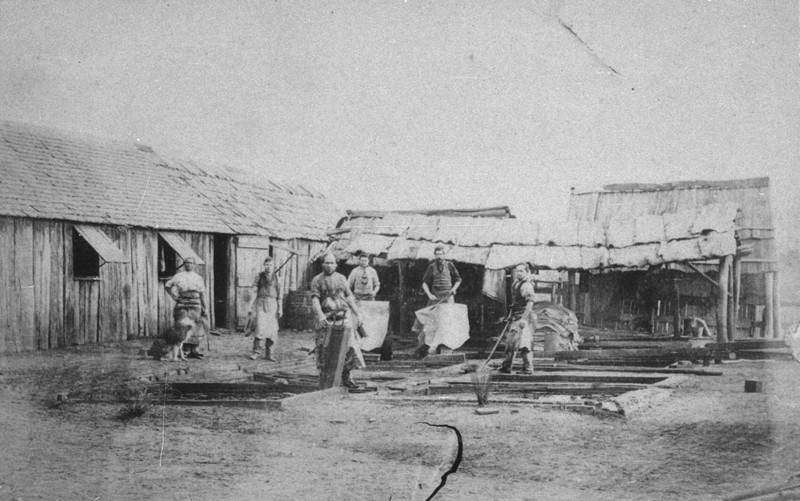
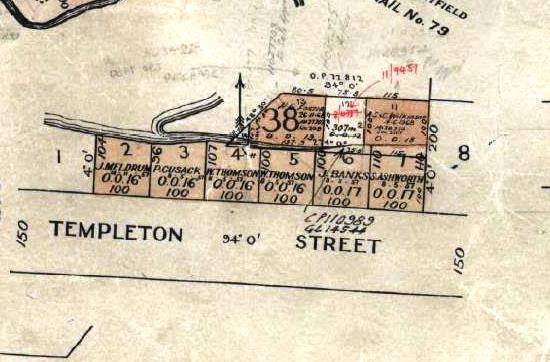
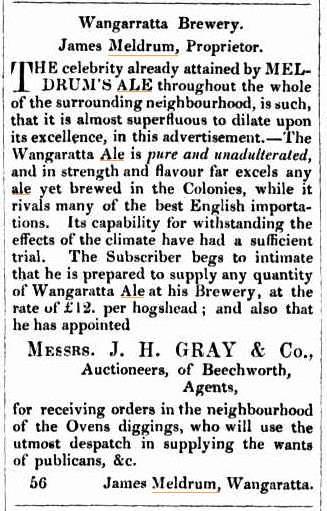
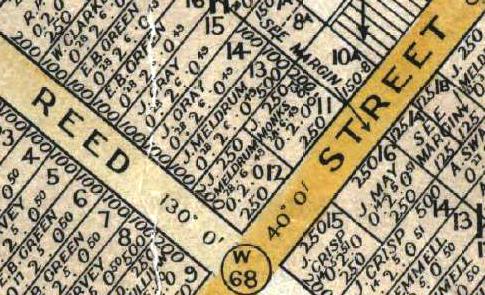
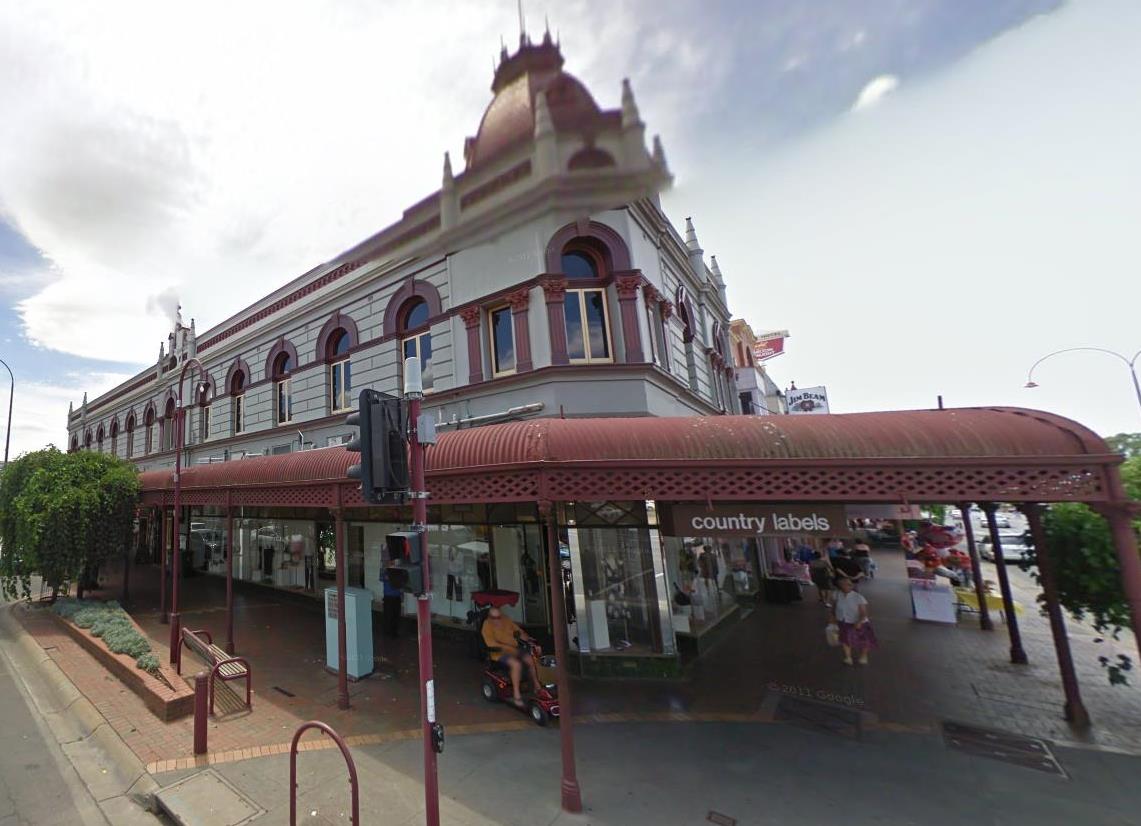




Trackbacks/Pingbacks